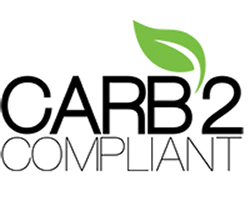


CARB stands for California Air Resources Board, also known as Air Resources Board (ARB). It is a department of the California Environmental Protection Agency. It was established in 1967 with the purpose of maintaining and improving air quality, and researching causes and solutions of air pollution. CARB's mandates, such as CARB 2 compliant MDF, are strict and usually are considered the standard across the United States.
What is CARB Phase 2 Compliant?
CARB Phase 1 and Phase 2 are a part of California's Composite Wood Products Regulation (CWP Regulation), which took effect in 2009 with Phase 1. The regulation has to do with reducing formaldehyde emissions from composite wood products, hardwood plywood, particleboard and medium density fiberboard (MDF). In the 2009 rollout of the CARB's Airborne Toxic Control Measure (ATCM), formaldehyde emissions were capped at .08 parts per million (ppm). CARB Phase 2 went into effect in 2010 and has much lower formaldehyde emissions than the previous phase; set at .05 ppm. A main reason why the CARB ATCM is the strictest air quality measure is because it CAPS emissions levels. Other air quality standards are averages.
Linen Shaker - Quick Ship
Ships in 3 to 6 business days
Accident Protection Warranty For Your Entire Laundry Room! Learn More!
The Linen Shaker cabinets are a simple, yet sophisticated collection that will bring a touch of class to any home. Featuring soft close drawers and doors, and an all plywood box construction, quality has not been overlooked. The delicate vanilla finish goes perfectly in any laundry room, from the most modern to the traditional style.
| Shipping Time: | Part of our Quick Ship program - ships in 3 to 6 business days |
| Style: | Shaker |
| Face Frame: | 3/4" x 1-3/4" Birch |
| Door Frame: | Premium HDF (HDF is used to avoid cracking/warping) |
| Door Center: | Premium HDF (HDF is used to avoid cracking/warping) |
| Door Frame Width: | 2.75" |
| Center Panel Beveled Edge: | Yes |
| Sides: | 1/2" A-Grade Plywood |
| Top & Bottom (Wall): | 1/2" A-Grade Plywood |
| Bottom (Base): | 1/2" A-Grade Plywood |
| Back Panel: | 1/2" A-Grade Plywood Full Back |
| Shelves: | Adjustable 3/4" w/Front Edge Banding |
| Base Cabinet Shelf Depth: | 1/2 |
| Drawer Box: | 5/8" solid hardwood, dovetailed drawer box, 5/16" Plywood Drawer Box Bottom, 5-Piece drawer front construction |
| Drawer Glides: | Undermount, Full Extension, Soft Close Glides |
| Base Corner Supports: | 3/4" Solid Wood Corner Blocks |
| Overlay: | Full |
| Hinges: | 6-way Adjustable, Concealed, European Soft Close Hinges |
| Cabinet Interior: | UV Coated Natural Interior (Prepped-for-glass cabinets will be finished to match the cabinet fronts) |
| Center Stile: |
None (unless listed in the cabinet description) |
| Assembly Method: | Metal Clip or Glue & Staple: Cabinets come with Metal Clips (Cleats - not already installed on the cabinets) that can be used to assemble or the cabinets can be Glued and Stapled. If Staple & Glued, clips will not be used |
| Finish: | 7 step, acid-catalyzed finish process with a UV coating |
| Toe Kick: | 1/2" Plywood |
| Installation Rail: | None |
| Wall Cabinet Bottoms Finished (Exterior): | Yes |
| CARB Compliant: | Yes |
| Door Hinges: | Doors come pre-drilled for the hinges, the face frame has marks where to drill and the customer chooses Right or Left during assembly. |
| Toe Kicks Included w/Base Cabinets: | Yes, but there will be a small gap when two cabinets are side by side, so the TKC (8' toe kick) is needed if cabinets are next to each other. |
| Sides Panels Finished: | Yes |
| Installation/Design Note: |
The cabinet depth measurement listed is the depth from the front of the face frame to the back of the cabinet, and does not include the cabinet door depth. Cabinet specs are subject to change without notice. *Cabinet measurements are typically converted from metric to inches and manufacturers will commonly round up to the nearest 1/4 inch. This can cause a measurement to be off by a fraction of an inch (less than 1/4") which is within normal industry standards* Schematic images and renderings are generic and may not represent exact construction details for each collection. The exact specifications for this collection can be found in the construction details listed above. |
Please note that all cabinet images are to show the final product, but assembly will be required.
Please note that all cabinet images are to show the final product, but assembly will be required.
Please note that all cabinet images are to show the final product, but assembly will be required.




